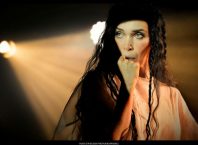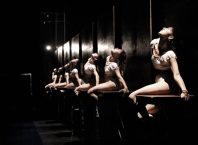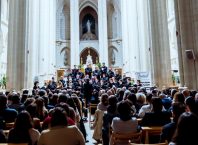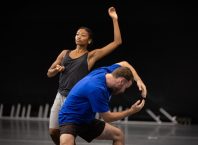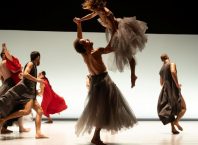“The feeling people get when they walk into a half-price store – that’s how I feel when I walk into a library – it makes me want more,” says choreographer Dana Ruttenberg, whose “NABA” for children will premiere at the Sounds of Childhood festival taking place at the Holon Theatre, October 4 – 7, during the Sukkot holidays. By offering her young audience “more”, Ruttenberg hopes to inspire that feeling of “wanting more” in her audience. NABA (the full title is “Na BaOzen” which means, literally, in Hebrew “moves in the ear”) is an unusual performance, complete with interactive gadgets, and lots of fun, challenging expectations and creating an opportunity to examine our relationship to sound and music; the way they affect our perception.
Too sophisticated for children? Not at all: “Children are very sophisticated,” says Ruttenberg, adding that although the original version of NABA has been adapted for children, she hasn’t simplified anything. On the contrary, she has added more musical selections to the soundtrack. The desire to experience and explore has always been important for Ruttenberg. After completing her military service, Ruttenberg set out for Columbia University intending to study Psychology, but wandered into the dance studio time and again, emerging with a joint degree in Dance and Film (magna cum laude!). Inspired by the abundance of cultural resources in New York, she would like that sense of discovery and level of engagement to be available to all audiences – including children. This belief is at the heart of the festival, which aims to present the best compositions and performances to young audiences.
Ruttenberg was inspired to create NABA when visiting a museum in Madrid. There were no more audio-guides available for a particular exhibit and a cluster of indignant people refused to enter the exhibit unless they were provided with headphones. This experience led Ruttenberg to reflect on the ways in which the aural experience guides the viewer through the exhibit, influencing the experience as a whole. Reversing the concept in NABA, Ruttenberg asks the question: what if the audience can determine the soundtrack, and in effect, create their individual perceptual experience through the choice of soundtrack.
Just as a dance work is affected by lighting, it is strongly affected by the accompanying soundtrack. While one is instantly aware of the impact of a spotlight on a particular dancer, the soundtrack works on a more subconscious level. Ruttenberg has isolated this element of the composition to emphasize it’s affect on the performance as a whole, and as a way of involving the audience. In a typical dance performance the audience is not usually aware of the way in which the choice of music affects the perception and reception of the performance. By giving her audience a choice, Ruttenberg highlights this element.
Each viewer receives a pre-programmed audio guide with headphones. On-stage instructions will indicate times in the performance when different tracks can be selected. As the sound comes exclusively through individual headphones, two viewers sitting side by side can listen simultaneously to different tracks and compare notes after the performance. Interestingly, by wearing earphones the audience shuts out many of the sounds which typically accompany a dance performance: the sound of the dancer’s breath and footsteps, the occasional whispers and coughs from the audience.
Ideally, it is a dance which should be seen more than once, in order to have a sense of the different viewing possibilities. Ruttenberg says, “It looks different to me each time I see it.” While audience members select different options of music and text, the dancers (who are all amazing performers, well worth watching even without any soundtrack at all) hear a neutral soundtrack, giving them a different experience as well. Ever ready to explore, Ruttenberg is contemplating changing the soundtrack for the dancers. In anticipation of a tour to Hungary in early December, Ruttenberg has translated the text to Hungarian and is creating an English translation for International Exposure in December.
NABA
Choreography: Dana Ruttenberg
Creating Dancers: Johanna Rogan, Idan Porges, Hagar Tennenbaum, Oshrat Banon (Moran Gross will perform as “Hagar” and Shaked Dagan as “Johanna” in the festival performances)
Costumes: Maor Zabar, Stage Design: Yair Gutterman
Producer: Mirit Ben-Weiss
Sound Design: Dudi Sofer and Gadi Raz
Rehearsal Director: Sharon Zuckerman
Lighting Design: Yaakov Sliv
Performances:Tuesday, October 6, 16:30
Holon Theatre, 11 Kugel Blvd
Tickets: 03-5023001/2/3
www.hth.co.il

